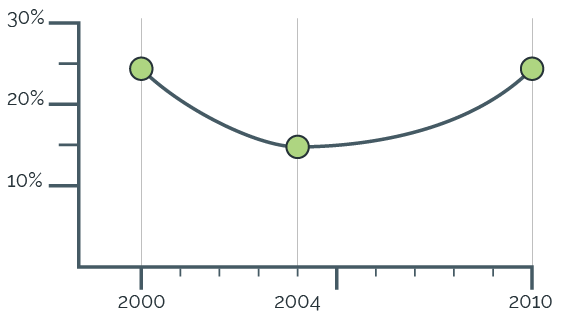My friend is a project manager for a website development company. The way she makes it sound, her job is like talking someone off a ledge. People get very emotional about their websites. Sheâs the one in the company with interpersonal skills, and she uses them to talk to clients about their sites. The developers do the tech stuff and sheâs the intermediary. Predictive analytics software and business intelligence couldnât be farther from her center of attention, but big data for project management can play a really important role.
Why Big Data for Project Management?
My project manager friend is working for a small business that, given its focus, is relatively stuck in the past. Thereâs a reason why itâs still a small business that had to move to a less expensive office. Task management is her only need, and all decisions are reactive.
One problem with the reactive stance is scope creep, which is what happens when you think the project fits into certain parameters, then you bill based on those parameters, but the projectâs scope keeps on widening until youâre in over your head. A business that doesnât use data to make accurate project-scope predictions wonât scale.
Big data helps you look back at past projects and forward at project projections for more efficiency and accuracy. How exactly does this work? Letâs start by defining our terms.
Analytics vs. Intelligence
Project managers donât have a lot of time to parse the difference between analytics and business intelligence. When youâre busy reacting to and working with clients and creatives, the last thing on your mind is big data nomenclature. Yet knowing what the different types of software bring to the table will help you determine what you really need.
The Pepperdine Graziadio School of Business has an infographic to help illuminate the difference between business analytics and business intelligence:
As you can see, analytics software is predictive, whereas intelligence software is primarily focused on past and present performance.
Business intelligence enables project managers to look at the metrics on past projects and derive a picture of what happened. How long, on average, do projects of a certain size take? When it comes to labor, what is the typical spend? If there were any additional expenses, what were they, and how often do they typically pop up in projects of a certain size?
Analytics, on the other hand, goes a step further. Given certain parameters, an analytics solution could tell you what to expect in terms of hours and spend. In other words, analytics can help put an end to scope creep.
Analytics can help you answer questions and create opportunities. Given the key performance indicators (KPIs) for an e-commerce site that was designed by your agency, how well can you expect a similar site to do in the future? Which features have similar sites added that really helped them get a good return on investment (ROI)? Given a clientâs target audience, what are the ballpark figures they can expect if they were to add certain features and content to their site?
Big data doesnât just allow you to minimize scope creep and optimize billing, it helps you get proactive in creating opportunities for yourself and your company.
Project Management Through Big Data
In keeping with what I noted about my friendâs project management software â she uses Asana to keep track of tasks and dependencies â Rachel Burger of GetApp notes that âmost project management software doesnât cover big data.â Ignorance or lack of responsiveness to big data can lead not just to scope creep, but to outright failure. Burger cites research from the Project Management Institute (PMI), including the following graph, which charts project failure from 2000 to 2010:

PMIâs researchers found that the high level of project failure in 2004 was due to ignorance. Companies and their project managers didnât know how to use new big data tools, which ended up costing the economy trillions of dollars.
Data-based Recommendations
In a study on how big data can mitigate project complexity, PMI provides a number of examples that project managers can convert into recommendations. Ultimately these recommendations require you to take a proactive stance. This isnât just about seeing a project through, itâs about getting out ahead with data to determine how a project can be more successful.
- Identify optimum communicators: Look at the nodes (communicators) in an information network and determine which communicators achieve the most touchpoints with other nodes. Use this information to select influencers for social media campaigns, brand ambassadors, and middle managers.
- Identify optimum communication times: Analyze response and engagement rates for emails and social media messages, then tailor their delivery times accordingly.
- Identify optimum images: People are attracted to and share content that includes images because itâs easier to interpret an imageâs meaning quicker than text. Find or create images that correspond with the emotional content of a social media post, and consider doing the same for email.
- Optimize your communication: Data shows that words related to positive emotions help content go viral more than negative words, and people act faster when text is easier to read. Use a simple, conversational style, and donât be afraid to occasionally include irony and profanity if the situation calls for it (according to PMIâs research, coarse language âdoes not necessarily bring about negative reactionsâ and âirony and simple language can bring about consensusâ).
Big Data Matters In Business
Whatever your objective is for a project, you can find data to influence its outcome. Through business intelligence, you can analyze past and real-time data and use them to come to your own conclusions. Through analytics, you can use past data to model the probability of a certain outcome for a project.
Either way, youâre using data to think about the best path to a projectâs success, instead of simply reacting. Oh, and one more thing: the project manager who uses data to back up their decisions has a higher level of credibility and objectivity. Combine objectivity with good instinct, and youâre sure to see positive outcomes for your projects.









